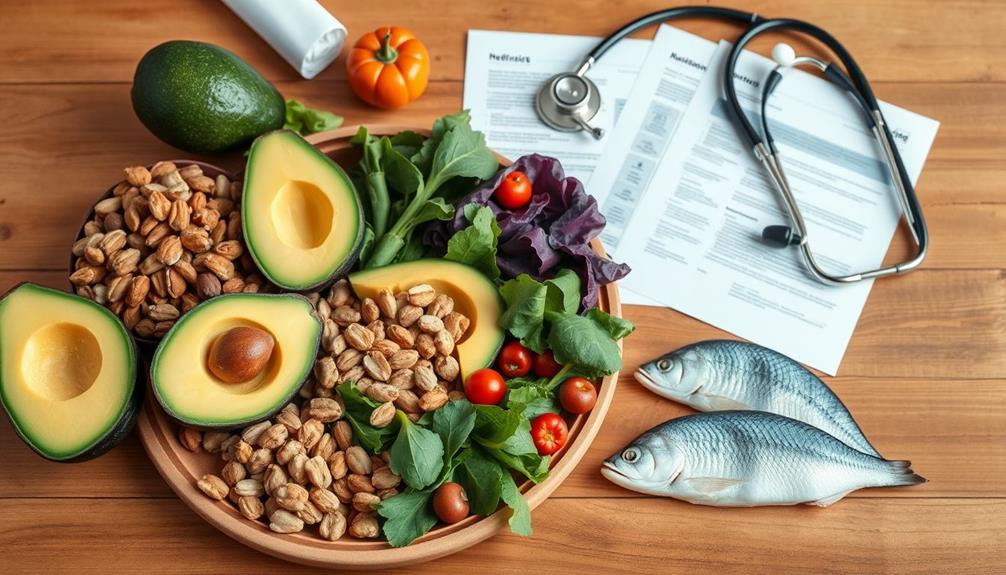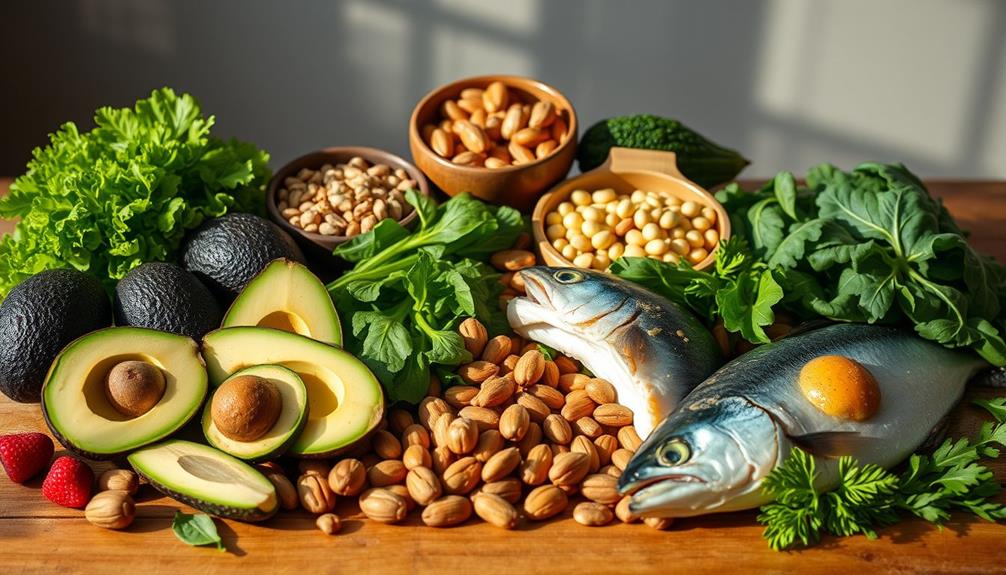To lose weight on the keto diet, focus on consuming high-fat foods while keeping your carbs below 50 grams daily. Aim for a macronutrient ratio of around 70-80% fat, 15-20% protein, and 5-10% carbohydrates. Include foods like avocados, nuts, leafy greens, and fatty fish. Avoid sugar and starches to maintain ketosis, which helps your body burn fat for energy. You might experience some initial side effects, commonly referred to as "keto flu," but they usually pass within a few weeks. Stick with it, and you'll uncover tips to make this dietary journey easier and more effective.
Key Takeaways
- Follow a macronutrient ratio of 70-80% fat, 15-25% protein, and 5-10% carbohydrates to induce ketosis for effective fat burning.
- Include high-fat foods like avocados, nuts, and fatty fish, while avoiding sugar and starchy foods to limit carbohydrate intake.
- Prepare a weekly meal plan with keto-friendly snacks to manage hunger and maintain adherence to the diet.
- Monitor ketone levels to ensure you remain in ketosis, adjusting macronutrient ratios based on personal goals and activity levels.
- Stay hydrated and increase electrolytes to combat "keto flu" symptoms during the adaptation phase of the diet.
Understanding the Keto Diet

If you're looking to lose weight, understanding the keto diet is crucial. The ketogenic diet focuses on a high-fat intake, typically around 70-80%, moderate protein (15-20%), and very low carbohydrates (less than 50 grams). This unique macronutrient ratio shifts your body from burning carbs to fats, inducing a metabolic state known as ketosis.
In ketosis, your body produces ketones from stored fat, providing an alternative energy source, especially important for your brain, which usually needs about 120 grams of glucose daily. Additionally, incorporating foods rich in antioxidants, such as certain low-carb vegetables, can enhance overall health while on a restrictive diet, promoting better wellness antioxidant-rich foods.
When you follow the keto diet, you'll want to include healthy fats like avocados, nuts, seeds, meats, fatty fish, and low-carb vegetables. On the flip side, avoid grains, sugars, most fruits, and starchy vegetables.
Many people experience significant initial weight loss on the ketogenic diet, often losing more weight than those on traditional low-fat diets, especially in the first three months.
However, during the initial adaptation phase, you might encounter the "keto flu," which includes symptoms such as fatigue, headache, and nausea. Don't worry; these side effects typically resolve within 3-4 weeks as your body adjusts to ketosis.
Key Macronutrient Ratios

To succeed on the keto diet, you'll want to focus on achieving the ideal macronutrient breakdown of 70-80% fat, 15-25% protein, and 5-10% carbohydrates.
Incorporating a balanced diet and regular exercise can enhance your results and support overall health.
Depending on your personal goals, you can adjust these ratios slightly to fit your needs, like increasing protein for muscle gain.
Understanding these key macronutrient ratios is essential for entering and maintaining ketosis effectively, especially when combined with effective strategies for weight loss.
Ideal Macronutrient Breakdown
Achieving the right macronutrient breakdown is vital for successfully following a ketogenic diet and promoting weight loss. The standard macronutrient ratio for a keto diet typically consists of approximately 70-80% fat, 15-25% protein, and 5-10% carbohydrates. This ratio aims for less than 50 grams of carbs per day to induce ketosis.
Here's a breakdown of popular macronutrient ratios for different ketogenic approaches:
| Diet Type | Fat (%) | Protein (%) | Carbohydrates (%) |
|---|---|---|---|
| Standard Ketogenic Diet | 70-80 | 15-25 | 5-10 |
| High-Protein Ketogenic Diet | 60 | 35 | 5 |
| Cyclical Ketogenic Diet | 70 | 25 | 5 |
| Targeted Ketogenic Diet | 70 | 20 | 10 |
When you maintain a high-fat diet with low-carb intake, you encourage fat loss while keeping protein levels sufficient to support muscle preservation. Monitoring ketone levels is essential to guarantee your body stays in a state of ketosis, maximizing the benefits of your ketogenic diet.
Adjusting Ratios for Goals
Adjusting macronutrient ratios can greatly impact your success on the ketogenic diet, especially when aligning with your specific weight loss goals and lifestyle.
Understanding your financial health is essential when planning any dietary changes, much like setting a budget for your finances.
The Standard Ketogenic Diet (SKD) typically consists of 70% fat, 20% protein, and 10% carbohydrates, which is effective for inducing ketosis.
However, if you're aiming for a higher protein intake, consider the High-Protein Ketogenic Diet (HPKD), which adjusts the ratios to around 60% fat, 35% protein, and 5% carbohydrates.
For those engaging in intense training, the Cyclical Ketogenic Diet (CKD) allows for alternating periods of strict keto with higher carb days, typically five days of low carbs followed by two days of higher carbs.
Meanwhile, the Targeted Ketogenic Diet (TKD) lets you consume 20-30 grams of carbs around your workouts, supporting performance while maintaining ketosis.
Foods to Include and Avoid

When starting on the keto diet, it's crucial to know which foods to include and which to avoid for effective weight loss. Focus on high-fat foods like avocados, nuts, seeds, oils, fatty fish, and meats, as these should make up about 70-80% of your daily caloric intake.
To support your overall health, consider incorporating vital oils known for their anti-inflammatory properties, such as essential oils for skin conditions that may enhance your wellness journey.
To keep your carbohydrate intake low, limit it to 20-50 grams per day by avoiding foods high in sugar and starch, such as bread, pasta, rice, and sugary snacks.
Incorporate low-carb vegetables like leafy greens, broccoli, and cauliflower. These options are nutrient-dense and provide fiber without greatly impacting your carb counts.
As for fruits, most should be avoided, but you can enjoy berries like strawberries and raspberries in moderation due to their lower sugar content.
Be mindful of dairy products; opt for full-fat options while steering clear of those with added sugars. Some people may also be sensitive to lactose, so pay attention to how your body reacts.
Meal Planning Strategies

To successfully navigate your keto journey, effective meal planning is crucial. Start by creating a weekly meal plan that emphasizes high-fat foods, like avocados, nuts, seeds, and fatty fish, along with low-carb vegetables.
Incorporating essential oils like eucalyptus oil can also support your overall health during this diet, helping with respiratory health and congestion, which can be beneficial as you adjust to dietary changes. This approach helps you minimize the temptation of high-carb foods and keeps you on track with your ketogenic diet goals.
Utilize meal planning strategies that include tracking net carbs. Pay attention to food labels, subtracting fiber and sugar alcohols from total carbohydrates to guarantee you stay under 50 grams daily.
Prepare keto-friendly snacks, such as cheese, olives, or nut butter, to manage hunger and reduce cravings between meals.
Consider batch cooking to streamline your meal prep. By preparing multiple servings at once, you'll have ready-to-eat options that align with your dietary needs.
If cooking isn't your thing, explore meal delivery services that cater specifically to ketogenic diets. This not only saves time but also assures you have meals that fit your keto lifestyle.
With these strategies in place, you'll find it easier to stick to your meal plan and achieve your weight loss goals effectively.
Health Benefits of Keto

When you follow the keto diet, you can experience impressive weight loss efficiency right from the start. Not only does this low-carb approach help you shed pounds, but it also improves your metabolic health by enhancing insulin sensitivity and lowering triglyceride levels.
Additionally, adopting a balanced diet while on keto can complement your efforts, as seen in the benefits of apple cider vinegar for weight loss. These benefits can greatly reduce your risk of serious health issues in the long run.
Weight Loss Efficiency
The ketogenic diet stands out for its impressive weight loss efficiency, especially when compared to traditional low-fat diets. Research shows that participants on a ketogenic diet can lose an average of 2 pounds more than those following low-fat plans over a similar timeframe. In just 8 weeks, individuals on this high fat diet may experience a mean weight loss of 13%, particularly beneficial for obese adults.
Additionally, understanding the significance of protecting your investments through sound financial practices can further enhance your overall well-being during your weight loss journey.
The keto diet helps with weight loss by promoting appetite suppression, which leads to reduced calorie intake. This appetite control is crucial for sustainable fat burning and overall weight loss success.
Additionally, improved insulin sensitivity and blood sugar control can further facilitate weight loss, with around 60% of type 2 diabetes participants reversing their condition after adopting the ketogenic diet.
Moreover, the diet demonstrates a greater reduction in triglycerides and boosts HDL cholesterol levels, both of which are essential for enhancing metabolic health.
Improved Metabolic Health
Experience a remarkable boost in your metabolic health by embracing the ketogenic diet. This low-carb, high-fat approach not only aids in weight loss but can greatly enhance your overall metabolic function.
One of the standout benefits is improved insulin sensitivity. Studies reveal that about 60% of participants with type 2 diabetes reversed their condition after just 16 weeks on the keto diet, which aligns with the importance of emotional regulation seen in BPD treatment options.
By following the ketogenic diet, you'll likely see considerable reductions in blood sugar levels, often leading to lower hemoglobin A1c percentages and decreased reliance on medications. Participants in research also reported greater reductions in triglycerides and higher HDL cholesterol levels, essential for heart health, compared to those on traditional low-fat diets.
Moreover, the keto diet helps reduce chronic inflammation linked to metabolic syndrome, which can lower your risk of heart disease and diabetes.
Remarkably, it promotes fat loss, particularly visceral fat around the abdomen, a vital indicator of metabolic health. By adopting the ketogenic diet, you're not just aiming for weight loss; you're setting the stage for improved metabolic health that can transform your life.
Common Side Effects

Many people starting on the ketogenic diet may encounter common side effects, often referred to as "keto flu," during the initial shift to ketosis. You might experience fatigue, headaches, nausea, and dizziness as your body adjusts.
Understanding toilet mechanics can be helpful during this period of adjustment, as the same principles of maintenance apply to managing your health. Irritability can also set in, making this change feel challenging. These symptoms usually occur within the first week and can be attributed to the body's shift in fuel sources.
Digestive issues, such as diarrhea or constipation, may arise due to a sudden increase in fat intake and decreased fiber from carbohydrates. Additionally, you may notice fruity-smelling urine, a byproduct of fat metabolism, indicating that ketones are in the system.
Electrolyte imbalances can contribute to muscle cramps and further fatigue, so it's important to increase your intake of sodium, potassium, and magnesium.
While many side effects generally resolve within 3-4 weeks as your body adapts to burning fat for fuel, it's vital to monitor your symptoms. If they persist or worsen, don't hesitate to consult a healthcare professional for guidance. This way, you can stay on track for successful weight loss while managing any discomfort.
Adapting to Keto

Adjusting to the keto diet requires a strategic approach to minimize discomfort and enhance your chances of success. Begin by gradually reducing your carbohydrate intake to 20-50 grams per day. This helps ease your body into the ketogenic adaptation and reduces the chances of experiencing the "keto flu."
Staying hydrated is essential, as you'll lose more water and electrolytes during this change, which can lead to fatigue and headaches. Additionally, consider incorporating caffeine to potentially boost your exercise performance, as caffeine may enhance endurance during your workouts.
Incorporate high-fat, low-carb foods like avocados, nuts, and oils into your meals. These foods not only promote satiety but also train your body to utilize fat for energy. As you stick to this diet, monitor your ketone levels using urine strips or blood ketone meters to confirm you've entered ketosis, typically within 3-4 days.
Initially, you might notice weight loss, but keep in mind that this is primarily water weight. Sustainable fat loss occurs after your body fully adapts to burning fats for fuel, usually within 1-2 weeks.
Long-term Sustainability

To guarantee you can stick with the keto diet over the long haul, it's essential to adopt a flexible approach that allows for the gradual reintroduction of healthy carbohydrates once you reach your weight loss goals. Aim for 50-100 grams of carbs per day to maintain metabolic flexibility while still promoting fat burning.
Incorporating practices such as mindfulness and stress reduction can also support your journey, as emotional well-being plays a significant role in dietary adherence and overall health. For instance, yoga for back pain can be beneficial not just for physical relief but also for mental clarity.
Incorporate a variety of low-carb, nutrient-dense foods, like non-starchy vegetables and healthy fats, to prevent nutrient deficiencies and support your overall health. Establishing a meal-prepping routine can help guarantee you have keto-friendly options readily available, reducing the temptation to revert to high-carb foods and enhancing your dietary adherence.
Engaging in regular physical activity and maintaining a balanced approach to macronutrient intake won't only enhance your results but also prevent weight regain after you shift off strict keto.
Continuous education about nutrition and seeking social support can empower you to make informed choices, fostering a sustainable eating pattern that aligns with your long-term weight loss and health goals.
Resources for Success

Finding reliable resources can greatly enhance your success on the keto diet. Start by consulting reputable sources like the Cleveland Clinic and Mayo Clinic for expert guidelines on the ketogenic diet. They provide insights that guarantee a safe approach to weight loss and highlight the health benefits of this low carb diet.
Join online forums and support groups where you can share experiences and gain motivation. These communities often offer practical tips from others who've successfully navigated the diet.
To effectively monitor progress, leverage health tools and calculators available online to track your macronutrient intake. This will help you stay within the targeted carb limit of 20-50 grams per day.
Don't forget to invest in keto cookbooks or websites filled with diverse recipes. This keeps your meals interesting while adhering to the high-fat, low-carb principles of the diet.
Regularly consulting with a registered dietitian can also guarantee nutritional adequacy tailored to your personal health needs. This support can be invaluable in your weight loss journey, helping you stay focused and motivated.
Frequently Asked Questions
How Do I Do Keto to Lose Weight?
To start keto for weight loss, limit carbs to 20-50 grams daily, focus on high-fat foods, guarantee moderate protein intake, meal prep regularly, and monitor your ketone levels to stay in fat-burning mode.
What Are the Basic Rules for Keto?
Many think keto's just about cutting carbs, but it's more. You need to limit carbs to 20-50 grams, focus on high fats, and stay hydrated to thrive. Meal prep helps you stick with it.
How Much Weight Can You Lose in 1 Week on Keto?
You can lose between 1 to 10 pounds in your first week on keto, mainly due to water weight. Strict adherence to carb limits and regular exercise can enhance your initial weight loss even more.
How to Start the Keto Diet the Right Way?
To start the keto diet right, calculate your macronutrient ratios, focus on keto-friendly foods, and plan meals ahead. Stay hydrated, balance electrolytes, and track your progress to guarantee you're effectively entering ketosis.
Conclusion
Incorporating the keto diet into your life can be a transformative journey, like discovering a hidden path in a familiar forest. By focusing on the right macronutrient ratios and planning your meals wisely, you'll not only shed those extra pounds but also enjoy a range of health benefits. Remember, adapting takes time, so be patient with yourself. With the right resources and mindset, you can make keto a sustainable part of your lifestyle, leading to lasting success.









